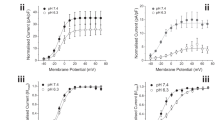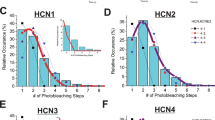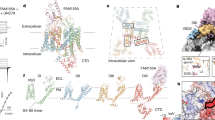Abstract
Ion channelopathies are inherited diseases in which alterations in control of ion conductance through the central pore of ion channels impair cell function, leading to periodic paralysis, cardiac arrhythmia, renal failure, epilepsy, migraine and ataxia1. Here we show that, in contrast with this well-established paradigm, three mutations in gating-charge-carrying arginine residues in an S4 segment that cause hypokalaemic periodic paralysis2 induce a hyperpolarization-activated cationic leak through the voltage sensor of the skeletal muscle NaV1.4 channel. This ‘gating pore current’ is active at the resting membrane potential and closed by depolarizations that activate the voltage sensor. It has similar permeability to Na+, K+ and Cs+, but the organic monovalent cations tetraethylammonium and N-methyl-d-glucamine are much less permeant. The inorganic divalent cations Ba2+, Ca2+ and Zn2+ are not detectably permeant and block the gating pore at millimolar concentrations. Our results reveal gating pore current in naturally occurring disease mutations of an ion channel and show a clear correlation between mutations that cause gating pore current and hypokalaemic periodic paralysis. This gain-of-function gating pore current would contribute in an important way to the dominantly inherited membrane depolarization, action potential failure, flaccid paralysis and cytopathology that are characteristic of hypokalaemic periodic paralysis. A survey of other ion channelopathies reveals numerous examples of mutations that would be expected to cause gating pore current, raising the possibility of a broader impact of gating pore current in ion channelopathies.
This is a preview of subscription content, access via your institution
Access options
Subscribe to this journal
Receive 51 print issues and online access
$199.00 per year
only $3.90 per issue
Buy this article
- Purchase on Springer Link
- Instant access to full article PDF
Prices may be subject to local taxes which are calculated during checkout




Similar content being viewed by others
References
Ashcroft, F. M. From molecule to malady. Nature 440, 440–447 (2006)
Venance, S. L. et al. The primary periodic paralyses: diagnosis, pathogenesis and treatment. Brain 129, 8–17 (2006)
Barchi, R. L. Protein components of the purified sodium channel from rat skeletal sarcolemma. J. Neurochem. 36, 1377–1385 (1983)
Trimmer, J. S. et al. Primary structure and functional expression of a mammalian skeletal muscle sodium channel. Neuron 3, 33–49 (1989)
Isom, L. L. et al. Primary structure and functional expression of the beta 1 subunit of the rat brain sodium channel. Science 256, 839–842 (1992)
Catterall, W. A. From ionic currents to molecular mechanisms: The structure and function of voltage-gated sodium channels. Neuron 26, 13–25 (2000)
Cannon, S. C. Pathomechanisms in channelopathies of skeletal muscle and brain. Annu. Rev. Neurosci. 29, 387–415 (2006)
Struyk, A. F., Scoggan, K. A., Bulman, D. E. & Cannon, S. C. The human skeletal muscle Na channel mutation R669H associated with hypokalemic periodic paralysis enhances slow inactivation. J. Neurosci. 20, 8610–8617 (2000)
Jurkat-Rott, K. et al. Voltage-sensor sodium channel mutations cause hypokalemic periodic paralysis type 2 by enhanced inactivation and reduced current. Proc. Natl Acad. Sci. USA 97, 9549–9554 (2000)
Bendahhou, S., Cummins, T. R., Griggs, R. C., Fu, Y. H. & Ptacek, L. J. Sodium channel inactivation defects are associated with acetazolamide-exacerbated hypokalemic periodic paralysis. Ann. Neurol. 50, 417–420 (2001)
Kuzmenkin, A. et al. Enhanced inactivation and pH sensitivity of sodium channel mutations causing hypokalaemic periodic paralysis type II. Brain 125, 835–843 (2002)
Armstrong, C. M. Sodium channels and gating currents. Physiol. Rev. 61, 644–682 (1981)
Bezanilla, F. The voltage sensor in voltage-dependent ion channels. Physiol. Rev. 80, 555–592 (2000)
Catterall, W. A. Voltage-dependent gating of sodium channels: correlating structure and function. Trends Neurosci. 9, 7–10 (1986)
Catterall, W. A. Molecular properties of voltage-sensitive sodium channels. Annu. Rev. Biochem. 55, 953–985 (1986)
Guy, H. R. & Seetharamulu, P. Molecular model of the action potential sodium channel. Proc. Natl Acad. Sci. USA 508, 508–512 (1986)
Horn, R. Coupled movements in voltage-gated ion channels. J. Gen. Physiol. 120, 449–453 (2002)
Gandhi, C. S. & Isacoff, E. Y. Molecular models of voltage sensing. J. Gen. Physiol. 120, 455–463 (2002)
Yarov-Yarovoy, V., Baker, D. & Catterall, W. A. Voltage sensor conformations in the open and closed states in ROSETTA structural models of K+ channels. Proc. Natl Acad. Sci. USA 103, 7292–7297 (2006)
Starace, D. M. & Bezanilla, F. A proton pore in a potassium channel voltage sensor reveals a focused electric field. Nature 427, 548–553 (2004)
Tombola, F., Pathak, M. M. & Isacoff, E. Y. Voltage-sensing arginines in a potassium channel permeate and occlude cation-selective pores. Neuron 45, 379–388 (2005)
Sokolov, S., Scheuer, T. & Catterall, W. A. Ion permeation through a voltage- sensitive gating pore in brain sodium channels having voltage sensor mutations. Neuron 47, 183–189 (2005)
Stefani, E. & Bezanilla, F. Cut-open oocyte voltage-clamp technique. Methods Enzymol. 293, 300–318 (1998)
Bulman, D. E. et al. A novel sodium channel mutation in a family with hypokalemic periodic paralysis. Neurology 53, 1932–1936 (1999)
Acknowledgements
We thank E. M. Sharp for technical assistance in molecular biology. This work was funded by research grants from the National Institutes of Health and the Muscular Dystrophy Association to W.A.C.
Author information
Authors and Affiliations
Corresponding author
Ethics declarations
Competing interests
Reprints and permissions information is available at www.nature.com/reprints. The authors declare no competing financial interests.
Supplementary information
Supplementary Information
This file contains Supplementary Methods, Supplementary Notes, Supplementary Table 1 and additional references. (PDF 874 kb)
Rights and permissions
About this article
Cite this article
Sokolov, S., Scheuer, T. & Catterall, W. Gating pore current in an inherited ion channelopathy. Nature 446, 76–78 (2007). https://doi.org/10.1038/nature05598
Received:
Accepted:
Issue Date:
DOI: https://doi.org/10.1038/nature05598
This article is cited by
-
Ion currents through the voltage sensor domain of distinct families of proteins
Journal of Biological Physics (2023)
-
Skeletal muscle CaV1.1 channelopathies
Pflügers Archiv - European Journal of Physiology (2020)
-
Myotonia in a patient with a mutation in an S4 arginine residue associated with hypokalaemic periodic paralysis and a concomitant synonymous CLCN1 mutation
Scientific Reports (2019)
-
Strength and muscle structure preserved during long-term therapy in a patient with hypokalemic periodic paralysis (Cav1.1-R1239G)
Journal of Neurology (2019)
-
A204E mutation in Nav1.4 DIS3 exerts gain- and loss-of-function effects that lead to periodic paralysis combining hyper- with hypo-kalaemic signs
Scientific Reports (2018)
Comments
By submitting a comment you agree to abide by our Terms and Community Guidelines. If you find something abusive or that does not comply with our terms or guidelines please flag it as inappropriate.



